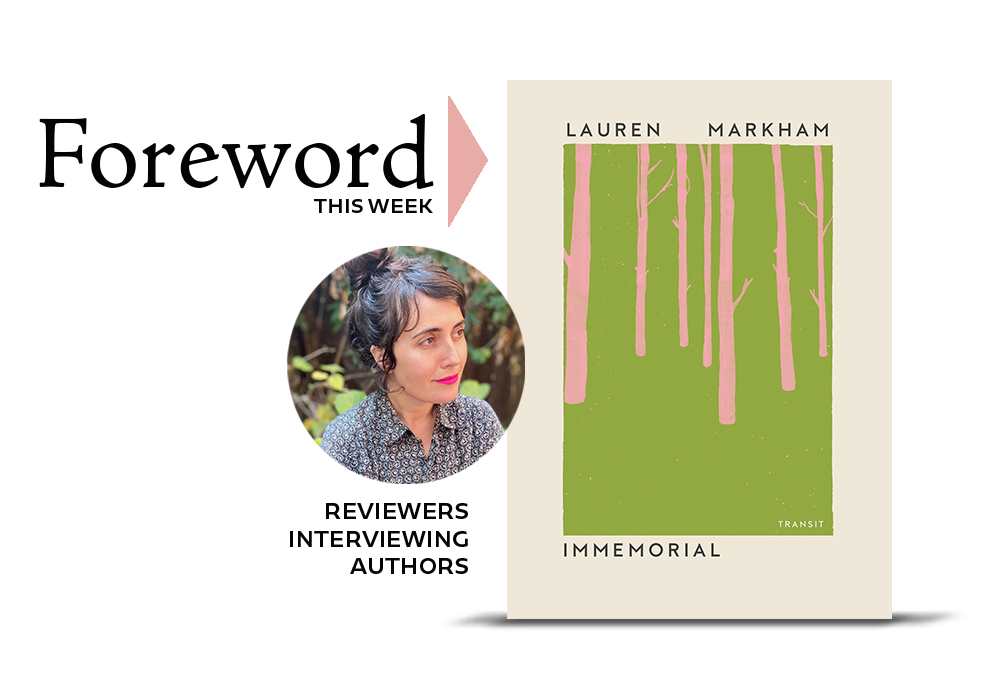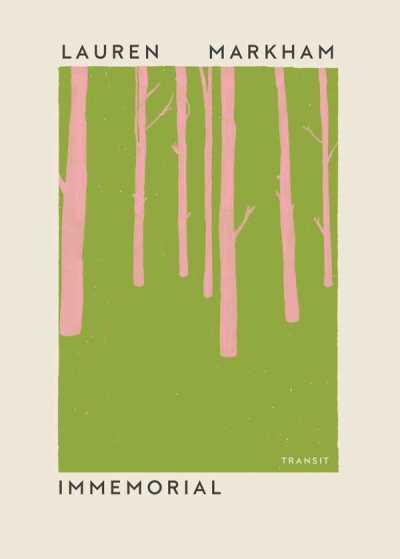Reviewer Rebecca Foster Interviews Lauren Markham, Author of Immemorial

The term “linguistic wear” points to the idea that a word used too often becomes stale and, after a while, numbs listeners to any meaning at all. English speakers are running into that issue with the language surrounding climate change. Yep, those two words are causing people to tune out.
In response, The Guardian scrapped a bunch of phrases and replaced them with stronger, more precise words. Climate emergency or climate breakdown instead of climate change; global heating rather than global warming; and, our favorite, climate science denier in place of climate skeptic. In truth, The Guardian editors and others, like today’s guest, Lauren Markham, recognize that “our planet is changing faster than our language is, and our retrograde lexicons don’t adequately reflect either what is happening or how it makes us feel.”

In Immemorial, her new collection of essays, Markham finds herself on a frustrating quest to discover—or invent—a word that captures her feelings of “grief at the state of the planet.” But that’s not quite it, she writes: it’s also “about the desire for a memorial, a sort of place to put the grief, or to sit with it, and feel it, or maybe mourn all that’s being lost.”
Markham expands on her wordyssey in the interview with Rebecca Foster below.
We’d be remiss by not mentioning that the essays in Immemorial are as good as any we’ve read in years, so consider gifting it to some of your big-thinking, environmentalist friends. Here’s some other great gift ideas (PDF) from our January/February issue, where Rebecca’s starred review of Immemorial appeared. A link to your free digital subscription to Foreword Reviews can be found here.
Part of your quest was to find a new word to capture the desire to memorialize what is passing away. Why was a neologism essential to the project?
Part of what this book reckons with—and what I reckon with as a writer, a journalist, and a human being living on this planet at this time—is the feeble nature of words to describe this rapidly changing world. Take the Palisades fire, which rages as we speak. “Rage”—what a rote way of describing what a fire does. It’s so rote, and so automatically invoked, the word in this context now ceases to mean or conjure much at all. How do we accurately and adequately describe the catastrophes of our age? And beyond that, what good does language do? What is it for?
Part of my quest was trying to make language alive and purposeful again. In his book Earth Emotions, the philosopher Glenn Albrecht writes, “It was clear to me that the English language had no term within it to describe what I had felt while overlooking the Hunter Valley,” the place he was raised and that he deeply loved. He coined the now-infamous term “solastalgia” to refer to the deep distress one feels when encountering the effects of climate change on a beloved place. “I needed a new concept, a canny one, which could be readily understood by ordinary people,” he writes. I felt something of the same when writing this book.
Recent years have seen the removal of many monuments representing outmoded principles. The book considers this as part of a more general reconsideration of the value and type of public memorials. What are some benefits and drawbacks of the iconoclastic movement?
A monument is something that is built at a particular moment in time, often to honor something or someone from the past. But time keeps moving, and so does (we hope) our relationship to and understanding of the past. I think it’s a good thing that we keep revisiting the past and interrogating the way we narrate history, what and who is lionized in the public sphere. But there’s also a problem of “we,” here. There is no one version of the past and there never will be. The past is a story we tell, and the nature of the story depends on who is telling it. As the toppling of Confederate monuments and the ensuing right-wing backlash make clear, we’re often divided on how we see the past and thus how we commemorate it. So a monument is a precarious object. Often, it’s a screen of projection.
You ponder the distinction between what is (intended to be) permanent and what is transient as it pertains to memory, monuments, and art. For example, rituals and performance art are deliberately evanescent. How do those one-time events function as memorials?
A memorial is an enactment of memory and grief. In my quest to find memorials related to climate grief, I became drawn to rituals—from the lament singers paid to sing at burials in Greece and Finland and Guatemala to death masks cast onto the face of the deceased to the poet C.A. Conrad, who bathes themself in the sound of extinct animals before entering a Walmart, to the artist Cara Levine, who digs a great big hole and invites people to place their grief inside of it. I loved the notion of an active form of memorial. A memorial that moves, and that demands something of the participant.
You asked earlier about the limitations of a monument—this thing fixed in time and space. I became interested in ritual because a ritual happens in time and then vanishes; it doesn’t need to assert any kind of permanence.
Are we seeing secular rituals taking over the role that religion once played in society? Can you give a few examples?
I don’t feel qualified to answer this question in the big picture, but I can say that I find myself turning to ritual for solace and seeking out new-to-me rituals, where I might otherwise have turned to religion. I was raised vaguely Episcopalian, I went to church and was confirmed, but I always understood religion as metaphor. Once I was an adolescent making choices of my own, the church really didn’t appeal to me.
Now, I find myself particularly drawn to rituals and spiritual practices that speak to a connection with the Earth itself. I don’t think I’m alone in this. I think many otherwise secular people are seeking out ritual and spiritual practices. We’ve seen a boom, for instance, in interest in astrology and tarot reading, as well as non-Indigenous people seeking out Indigenous medicines like ayahuasca. I can’t say if this is in explicit reaction to the climate crisis, but I sense a connection. In times of upheaval, we look for connection, for god.
There was a spiritualist boom in the late 19th century, which is now widely seen as a response to the hulking mechanization of the Industrial Revolution. What else did life have to offer? We now have our own spiritualist revival of sorts in the midst of climate catastrophe and, perhaps, in response to the great tech boom. I think people are seeking practices that provide meaning and that forge connection between their inner and outer worlds.
One of my takeaways from the book is that nothing is evolving fast enough to cope with climate breakdown—not species’ traits; not human language or behavior. What can we do, individually and collectively, to adapt?
This is a lovely (if devastating) takeaway. There is so much we can do to adapt! We can build more sustainable houses (I just read an article about a house built in Greece that requires hardly any winter heating or summer cooling). We can move away from a dependence on fossil fuel. We can subsidize new technologies and disincentivize (or ban, for goodness’ sake!) technologies that harm us. The ability to adapt is like the entire premise of the elusive Green New Deal!
The devastating thing about living during these times is that we can adapt, but lawmakers tend to put near-term profit above adaptive technologies and policies—and thus ahead of the health and survival of the planet, of us. At the same time, much adaptation already has happened, and continues to. It’s important to recognize that. Rebecca Solnit and Thelma Young Lutunatabua assembled an excellent book called Not Too Late which outlines many ways that we have already adapted and that we still can.
On the one hand, are preppers prioritizing survival skills? On the other, are those emphasizing inner resilience? Is the climate crisis best approached as a practical dilemma or a spiritual one?
Both/and! That’s the thing—we need to acknowledge the many dimensions of the crisis we’re living in. It’s a spiritual and psychic crisis. An ecological crisis. A logistical crisis. A crisis of values, of capital, of political will, of clarity. If we focus too much on the grief and mourning, we risk just folding into ourselves and collapsing. (Or just hosting a lifelong pity party).
We have work to do! But if we ignore the psychic difficulty of living in this time of vanishing and loss, I think we lose something, too. Because the psychic space is what propels us to act, to demand action. It’s also where we source new visions for the future.
During the planning and writing of this book, you became a mother. Rebecca Solnit remarked to you, “You’re choosing the future.” Did committing to parenthood at this point in history feel like an act of optimism, or defiance? To what extent do you think of a child, or a book, as a personal memorial?
What a great question. I have to say, I chose to have a child because I wanted to have a child, and because I love the world. It seemed to me that on no ecological balance sheet did it make sense to have a kid. But that’s why Rebecca’s words were so powerful: as usual, she distilled it perfectly. Yes: I was choosing the future. I’m not sure if I felt defiant, explicitly. But I felt, and feel, like the future needs us and we it. That was true before I had a child, and her existence only adds another luminous dimension to that truth. And I love the idea that she is a kind of memorial—to the past, to this ever-shifting present, and to the future, too. Thanks for that.
Rebecca Foster
